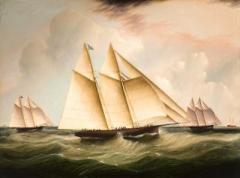- FINE ART
-
FURNITURE + LIGHTING
Shop By Category
Shop By Artist
- NEW + CUSTOM
- DECORATIVE ARTS
-
JEWELRY
Shop By Category
Shop By Artist
- INTERIORS
- MAGAZINE
James Edward Buttersworth
American, 1817 - 1894
James Buttersworth Artist Bio
James Buttersworth (1817-1894) was a prominent marine painter born in Middlesex County, England, into a family with a legacy of marine art. He immigrated to the United States around 1845, settling in West Hoboken, New Jersey. His proximity to New York Harbor, a hub of maritime activity, inspired his focus on capturing the grandeur of sailing ships, clippers, and naval battles.
Buttersworth is celebrated for his dynamic depictions of vessels under full sail, set against dramatic skies and churning seas. His distinctive style features elongated hulls and sails that convey a sense of movement, often framed by low horizon lines that enhance the dramatic effect. He worked primarily in oil, applying thin layers to achieve meticulous detail while infusing his scenes with a Romantic sense of drama.
Throughout his career, Buttersworth collaborated with Nathaniel Currier and Currier & Ives, which helped popularize his work through lithographs. His paintings not only documented the evolution of maritime transportation but also celebrated the thrill of yacht racing and naval history. His legacy endures in museum collections, including the Farnsworth Art Museum and the Peabody Essex Museum. Notably, his piece Off Barbados captures a British warship during a pivotal moment of naval history, showcasing his mastery of the genre.
James Buttersworth (1817-1894) was a prominent marine painter born in Middlesex County, England, into a family with a legacy of marine art. He immigrated to the United States around 1845, settling in West Hoboken, New Jersey. His proximity to New York Harbor, a hub of maritime activity, inspired his focus on capturing the grandeur of sailing ships, clippers, and naval battles.
Buttersworth is celebrated for his dynamic depictions of vessels under full sail, set against dramatic skies and churning seas. His distinctive style features elongated hulls and sails that convey a sense of movement, often framed by low horizon lines that enhance the dramatic effect. He worked primarily in oil, applying thin layers to achieve meticulous detail while infusing his scenes with a Romantic sense of drama.
Throughout his career, Buttersworth collaborated with Nathaniel Currier and Currier & Ives, which helped popularize his work through lithographs. His paintings not only documented the evolution of maritime transportation but also celebrated the thrill of yacht racing and naval history. His legacy endures in museum collections, including the Farnsworth Art Museum and the Peabody Essex Museum. Notably, his piece Off Barbados captures a British warship during a pivotal moment of naval history, showcasing his mastery of the genre.



















